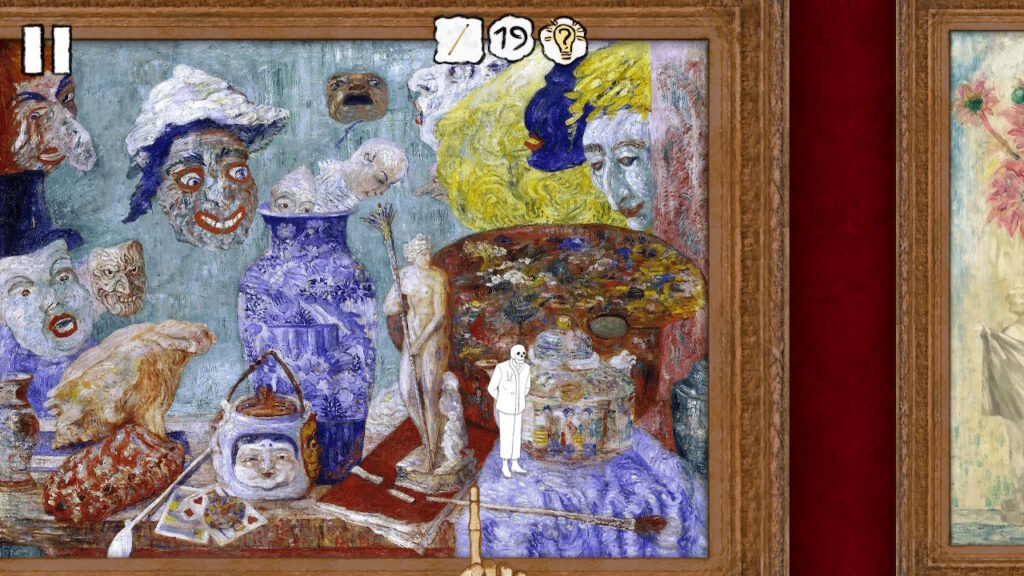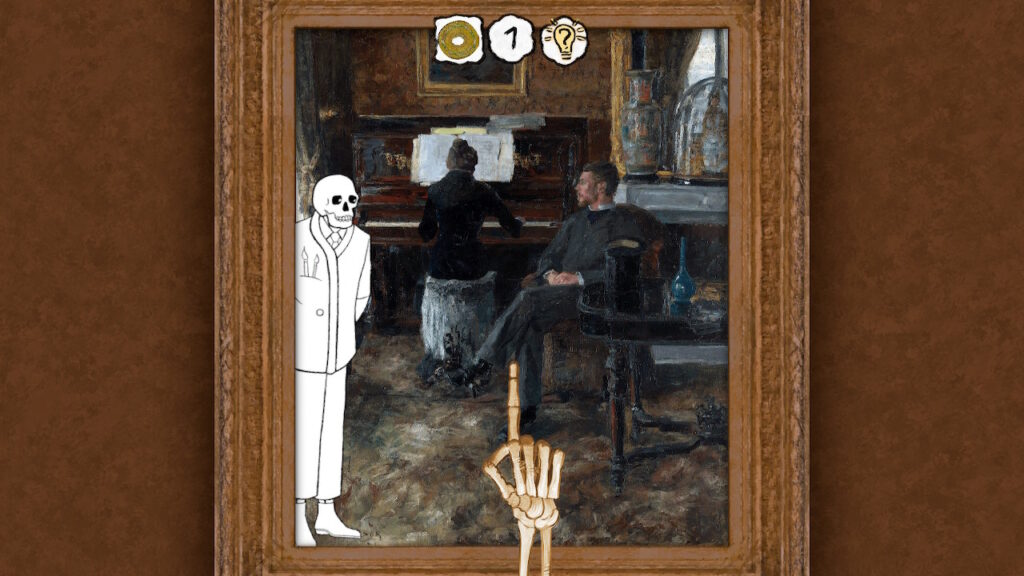If the first Please, Touch The Artwork felt like a reflective walk through Mondrian’s orderly universe of shapes and lines, then Please, Touch The Artwork 2 throws you headfirst into a theatrical mask parade led by the risen corpse of James Ensor himself. Less a puzzle game and more an interactive art piece, this sequel trades logical rigour for visual poetry—and it’s a trade that pays off. We got to experience it on the Nintendo Switch, where its relaxed pace and point-and-click simplicity find a natural home.
Where’s Waldo… in symbolism?
In Please, Touch The Artwork 2, you’re not solving puzzles so much as snooping through Ensor’s fantastically bizarre compositions, which are filled with masked figures, skeletons, and seaside melancholia. This time around, the challenge lies in spotting well-hidden objects across five thematic chapters that loosely mirror the painter’s own life and works, beginning, quite fittingly, at his own grave before spiralling into the coastal dreamscapes of Ostend, where he was both born and buried.
As a hidden object game, it keeps things streamlined. The controls are intuitive, and thanks to its zoom-and-hint system, you’ll never find yourself rage-quitting over a misplaced shell or ghostly bird. Instead, Please, Touch The Artwork 2 opts for something gentler and more profound: it invites you to slow down, explore, and really look.
Hidden treasures in brushstrokes
One of the great triumphs of this sequel is how respectfully and creatively it integrates game mechanics into Ensor’s original works. The hidden objects never feel tacked on or disruptive—in fact, they often enhance your appreciation for the texture, humour, and layered detail within each piece. Studio Waterzooi, with help from its illustrators, shows real restraint and sensitivity here. The result is a game where the art is the main character, and the gameplay merely guides you deeper into it.
Animations lean into the surreal, with a delightful Monty Python-esque flair that never undermines the artwork but instead adds levity and life. Skeletons dance, saints chuckle, and subtle Easter eggs abound—like a blink-and-you-miss-it cameo from Thomas Waterzooi himself. These flourishes don’t just earn a smile. They reinforce the idea that interacting with art can be both respectful and fun.
A museum you can touch
Please, Touch The Artwork 2 isn’t out to dazzle with gameplay depth, but that’s precisely its charm. In many ways, it achieves something that few games do: it makes you notice. Touching the artwork—even digitally—reshapes your relationship with it. You’re no longer a passive observer behind a velvet rope; you’re in there, part of the canvas.
The game makes a quiet case that while museums are invaluable, they don’t always give us the time or permission to linger and truly engage. Here, you can do just that—zooming in, poking around, listening to period-appropriate music (including a composition by Ensor himself), and soaking in the strange beauty of symbolism. Despite its subject, the game remains entirely accessible. There’s no required reading, no prior art knowledge needed. This is cosy culture: come as you are.
Conclusion
Please, Touch The Artwork 2 isn’t reinventing hidden object games, but it does give them a deeper sense of meaning and purpose. By framing play as a form of art appreciation, it becomes something more: a game that teaches you to see differently. It may not deliver hours of deep mechanics or complex systems, but what it offers is arguably more valuable—a genuine connection to a legendary artist and a uniquely engaging way to experience his world.
Whether you’re looking for a break from boss fights, grinding, and twitch reactions—or you’re an art teacher desperately trying to spark appreciation for modern art in your students—this might just be your next great escape.




